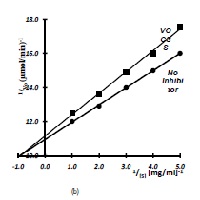Oil of C. sinensis inhibits pathogenic bacteria
Keywords:
Camellia sinensis, volatile oil, pathogenic bacteria, antibacterial, extracellular protease, Shigella dysenteriaeAbstract
Context: In spite of great advances observed in modern medicine, plants still make an important contribution to health care. Hence, there is need for unrelenting effort in the exploration of the health benefit of medicinal plants. Purpose: This work was designed to determine the role of the volatile oil of Camellia sinensis on the extracellular protease, which is one of the major virulent factors in the pathogenesis of Shigella dysenteriae and its antibacterial effects on eight other enteric bacterial as compared with the antibiotics Finding: The total antimicrobial effect of the volatile oil (355.0 mm) was significantly higher (p<0.05) than the antibiotics tested (203.0 mm). The minimum inhibitory and bactericidal concentrations of the oils revealed Escherichia coli as the most sensitive. However, relatively higher concentrations of the oils is required to achieve similar sensitivity against Salmonella and Shigella species. The activity of the partially purified extracellular protease, which is one of the virulence factors of Shigella dysenteriae was inhibited by the oil from different parts of the plant especially the leaf. The activity of this enzyme increased steadily between pH 7.0 – 8.0 and 40 – 50 oC. Summary: The volatile oils possessed antimicrobial activity and showed both competitive and noncompetitive kinetic inhibition of the extracellular protease of Shigella dysenteriae. Implication: The inhibitory action of the oil on protease from Shigella dysenteriae suggests the possible mode of action. Volatile oil from Camellia sinensis, especially the leaf, may be an important source of antibiotic against these organisms particularly Shigella dysenteriae.
References
Harkental M, Serrital JA. Comparative study of the in vitro antimicrobial activity of Australian tea tree oil, Cajeput oil, Niaouli oil, Manuka oil, Kanuka oil and Eucalyptus oil. Pharmazie, 2009;54(6): 460-463.
Kulandhaivel M, Palaniswamy M. In vitro antimicrobial activity of Camellia sinensis and Myristica fragrans against Staphylococcus aureus, Pseudomonas aeruginosa, Candida albicans. Int J of Pharm and Biol Ach, 2012;3(3): 604-609.
Perva-Uzunalić A, Škerget M, Knez Z, Weinreich B, Otto F, Grüner S. Extraction of active ingredients from green tea (Camellia sinensis): Extraction efficiency of major catechins and caffeine. Food Chem, 2006;96(4): 597-605.
Mbata TI, Debiao LU, Saikia A. Antibacterial activity of the crude extract of Chinese green tea (Camellia sinensis) on Listeria monocytogenes. Afr J of Biotech, 2008;7(10): 1571-1573.
Olosunde OF, Abu-Saeed K, Abu-Saeed MB. Phytochemical screening and antimicrobial properties of a common brand black tea (Camellia sinensis) marketed in Nigerian environment. Adv Pharm Bulletin, 2012;2(2): 259-263.
Fujik H. Green tea: Health benefits as cancer preventive for humans. The Japan Chem J, 2005;5(3): 119-222.
Hale TL, Keusch GT. 'Shigella': Structure, Classification and Antigenic Types. In: Baron's Medical Microbiology. Baron S et al, editors, University of Texas Medical Branch, 4th ed. ISBN 0-9631172-1-1, 2006.
Ryan KJ, Ray CG. Sherris Medical Microbiology. McGraw Hill, 4th edition, ISBN 0838585299, 2005.
Germani Y, Sansonetti PJ. The Genus “Shigella”. The Prokaryotes: Proteobacteria: Gamma subclass, 2006;6(3): 99-122.
Sandvig K, Van-Deurs B. "Entry of ricin and Shiga toxin into cells: Molecular mechanisms and medical perspectives". EMBO J, 2000;19(22): 5943-5950.
Kenneth T. Mechanisms of Bacterial Pathogenicity. Todar’s online textbook of bacteriology. 2012 [cited 2012 Sep 17]; [about 4p.]. Available from; http://textbookofbacteriology.net/themicrobialworld/pathogenesis.html
Meta JK, Nicole CK. Bacterial outer membrane vesicles and the host-pathogen interaction. Genes and Dev, 2005;19: 2645-2655.
World Health Organization (WHO). Second meeting of the sub-committee of the expert committee on the selection and use of essential medicines, Geneva, 2008; [cited 2012 Sep 17]; [about 6p.]. Available from www.who.int/selection_medicines/committees/subcommittee/2/ceftriaxone.pdf
Wannissorn B, Maneesin P, Tubtimted S, Wangchanachai G. Antimicrobial activity of essential oils extracted from Thai herbs and spices. Asian J Food Ag-Ind, 2009;2(4): 677-689.
Sharmin S, Towhid HMD, Anwar MN. Isolation and characterization of a protease producing bacteria Bacillus amovivorus and optimization of some factors of culture condition for protease production. J Biol Sci, 2005;5: 358-362.
Lowry OH, Rosebrough NJ, Farr AL, Randall RJ. Protein measurement with Folin phenol reagent. J Biol Chem, 1951;193: 265-273.
Chopra AK, Mathur DK. Purification and characterization of heat stable protease from Bacillus stereothermophilus RM- 67. J Dairy Sci, 1985;68: 3202-3211.
Padmapriya B, Rajeswari T, Nandita R, Raj F. Production and Purification of Alkaline Serine Protease from Marine Bacillus species and Its Application in Detergent Industry. Eur J of Appl Sci, 2012;4(1): 21-26.
Makino K, Tomihiko K, Tsutomu N, Tomio I, Masaomi K. Characteristics studies of the extracellular protease of Listeria monocytogenes. J Biol Chem, 1981;133: 1-5.
Keskin D, Oskay D, Oskay M. Antimicrobial Activity of Selected Plant Spices Marketed in the West Anatolia. Int J of Agric Biol, 2010;12: 916-920.
Ayoola GA, Lawore1 FM, Adelowotan T, Aibinu IE, Adenipekun E, Coker HAB, Odugbemi TO. Chemical analysis and antimicrobial activity of the essential oil of Syzigium aromaticum (Clove). Afr J Microbiol Res, 2008;(2): 162-166.
Louboudy SS, Bayoumi RA, El-Sehraway MH, Abd-El-Baseer MA. Isolation, purification, characterization, and physiological behavior of drinking water-borne pathogenic bacteria. New Egyptian J Microbiol, 2007;17(2): 105-120.
Adeola SA, Folorunso OS, Amisu KO. Antimicrobial Activity of Ocimum basilicum and its Inhibition on the Characterized and Partially Purified Extracellular Protease of Salmonella typhimurium. Res J Biol, 2012;2(5): 138-144.
Cox GM, Mukherjee J, Cole GT, Casadevall A, Perfect JR. Urease as a virulence factor in experimental cryptococcosis. Infect Immun, 2000;68: 443-448.
George OUO, Odibo FJC. Purification and Some Properties of Thermostable Alkaline Serine Protease from Thermophilic Bacillus species Gs-3. J Biol Sci, 2011;11(4): 299-306.



